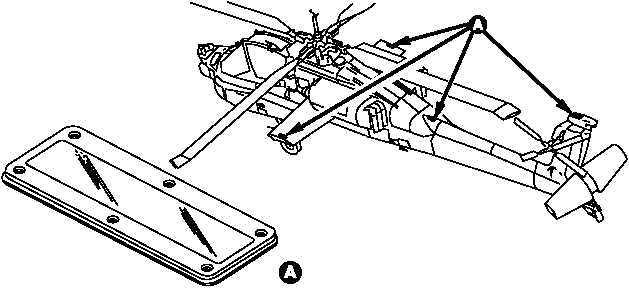TM 1-1520-238-T-6
9–16
9–2.
LOCATION AND DESCRIPTION OF MAJOR COMPONENTS (cont)
9–2
h. Formation Lights.
Formation lights (fig. 9–6) are flush–mounted electro–luminescent lamps which
consist of a formation light which is located on top of each wingtip, a formation light which is located on top of the
fuselage aft of the equipment bay, and a formation light which is located on top of the vertical stabilizer.
FORMATION LIGHT
(TYPICAL)
M69-107
Figure 9–6.
Formation Lights Major Components Location
i. Anti–Collision Lights.
Anti–collision lights (fig. 9–7) consist of two anti–collision light assemblies and a
power supply. One anti–collision light assembly is located on each wingtip. Each lamp assembly contains one
white lamp and one red lamp for day and night operations. The anti–collision light power supply is a LRU which
contains capacitors and circuitry to change 115 VAC inputs to 200–400 VDC outputs. The power supply is
mounted on a bulkhead on the left side of the main transmission bay.
j. Landing/Search Light Assembly.
The landing/search light assembly (fig. 9–8) consists of a lamp, a
motor for extension/retraction, and a motor for rotation. The landing/search light provides illumination for landing,
taxiing, hovering, takeoff, and search operations. The light assembly is mounted in a fairing on the bottom right
side of the helicopter, forward of the landing gear.
k. Maintenance and Utility Lights.
Maintenance lights (fig. 9–9) are hand–held detachable lamps. Each
lamp has a long electrical cord and a rheostat for adjusting the intensity of the light and can be attached at either
of two power source points on the aircraft:
Connector J111 in the aft avionics bay.
Connector J112, behind ground service utility door B60R under the front end of the right hand
FAB.
l. Utility and Secondary Lights.
The pilot and CPG utility lights (fig. 9–10) are located in the pilot and
CPG stations, on the left bulkhead above the lighting control panel. A utility light mounting bracket retains the light
and provides for quick detachment for use. A switch/rheostat, mounted on the back of the light, provides on/off
and dim/bright control. There are seven (DS1 through DS7) secondary lights spaced across the glareshield (fig.
9–10) above the pilot and CPG’s instrument panel. Each secondary light is a floodlight assembly which consists of
a lamp, a lamp retainer, and a lamp cover with a blue lens.

